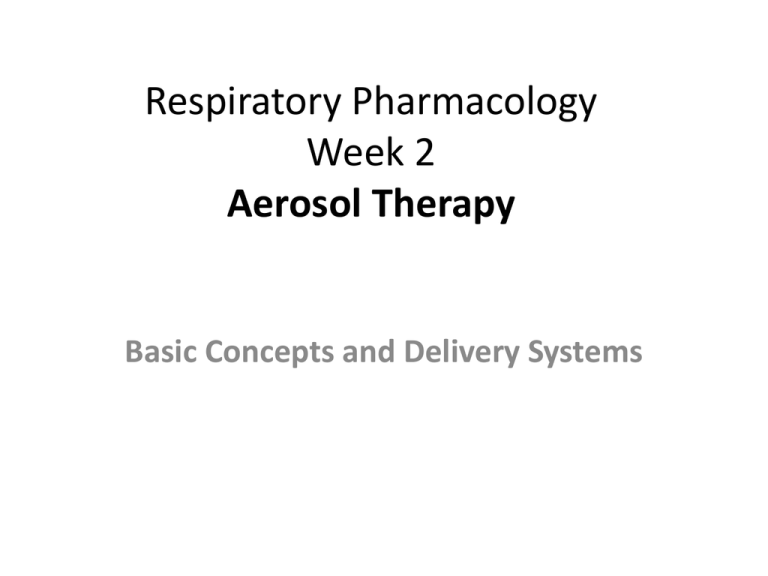File - Respiratory Therapy Files
advertisement

Respiratory Pharmacology Week 2 Aerosol Therapy Basic Concepts and Delivery Systems Aerosol Therapy • It is important to remember that an aerosol is not the same as humidity. • Humidity is water in a gas in molecular form, while an aerosol is liquid or solid particles suspended in a gas. • Examples of aerosol particles can be seen everywhere: as pollen, spores, dust, smoke, smog, fog, mists, and viruses. Aerosol Therapy • Aerosol therapy is designed to increase the water content delivered while delivering drugs to the pulmonary tree • Deposition location is of vital concern • Some factors that affect aerosol deposition are aerosol particle size and particle number along with how the medication is instructed to be taken Aerosol Output • The actual weight or mass of aerosol that is produced by nebulization. • Usually measured as mg/L/min also called aerosol density • Aerosol output does not predict aerosol delivery to desired site of action. Aerosol Devices • Small Volume Nebulizer (AKA: Hand Held Nebulizer, MedNeb, Free-flow…) • Large Volume Nebulizer (used with bland aerosol) • MDI and DPI Prior to Administration of any Aerosolized Medication • Verify MD order – Requires a frequency, dosage, modality – Ex: • • • • Medication: Albuterol Dosage: 2.5mg in 3ml normal saline Frequency: QID and Q2 PRN for wheezing Modality: SVN • Sign off order upon administation of drug – Specify date and time of administration Delivering a SVN • Patient instruction is important for proper delivery. – Slow deep breathing replicates laminar flow, allows for better deposition – Periodic breath holds (every 3rd or 4th breath is good) – Using a mouth piece is best – Use 8LPM on the flow meter for most medications Particle Size • The particle size of an aerosol depends on the device used to generate it and the substance being aerosolized. • Particles of this nature, between 0.005 and 50 microns, are considered an aerosol. • The smaller the particle, the greater the chance it will be deposited in the tracheobronchial tree. • Particles between 2 and 5 microns are optimal in size for depositing in the bronchi, trachea and pharynx. • Particles >10 microns useful to treat nasopharyngeal or oropharygeal regions • Particles 5-10 microns deposition to the more central airways • Particles 2-5 lower respiratory tract • Particles 0.8-3 microns increased delivery to the lung parenchyma, terminal airways Particle Size • Heterodisperse: – aerosol with a wide range of particle sizes (medical aerosols) • Monodisperse: – aerosol consisting of particles similar in size (laboratory, industry) Deposition • The aerosol particles are retained in the mucosa of the respiratory tract. They get stuck! • The site of deposition depends on size, shape, motion and physical characteristics of the AIRWAYS Mechanism resulting in Deposition: Inertial Impaction • Moving particles collide with airway surface. – Large particles (>5micros), upper and large airways • Physics: the larger the particle, the more likely it will remain moving in a straight line even when the direction of flow changes. • Physics: greater velocity and turbulence results in greater tendency for deposition Mechanism resulting in Deposition Table: Particle size and area of deposition. Particle Size in Microns 1 to 0.25 1 to 2 2 to 5 5 to 100 Area of Deposition Minimal settling Enter alveoli with 95% deposition Deposit proximal to alveoli Trapped in nose and mouth Mechanism resulting in Deposition: Sedimentation • Particles settle out of aerosol suspension due to gravity. • The bigger it is the faster it settles! • Directly proportional to time. • The longer you hold your breath the greater the sedimentation Mechanism resulting in Deposition: Diffusion • Actual diffusion particles via the alveolar-capillary membrane and to a lesser extent tissue-capillary membranes of respiratory tract • Lower airways: 2-5 microns • Alveoli: 1-3 microns • These values are from your book Deposition of Particles is also affected by: • Gravity – – Gravity affects large particles more than small particles, causing them to rain-out. • Viscosity - The viscosity of the carrier gas plays an important role in deposition. • For example, if a gas like helium, which has a low viscosity and molecular weight, is used as a carrier gas, gravity will have more of an effect upon the aerosol. • Helium is very light and hence can't carry these particles well, leading to rain-out and early deposition. Deposition of Particles is also affected by: • Kinetic activity - As aerosolized particles become smaller, they begin to exhibit the properties of a gas, including the phenomenon of "Brownian movement." • This random movement of these small (below l mm) particles causes them to collide with each other and the surfaces of the surrounding structures, causing their deposition. • As particle size drops below 0.1m, they become more stable with less deposition and are exhaled. Deposition of Particles is also affected by: • Particle inertia (repeated) - Affects larger particles which are less likely to follow a course or pattern of flow that is not in a straight line. • As the tracheobronchial tree bifurcates, the course of gas flow is constantly changing, causing deposition of these large particles at the bifurcation. Deposition of Particles is also affected by: • Composition or nature of the aerosol particles - Some particles absorb water, become large and rain-out, while others evaporate, become smaller and are conducted further into the respiratory tree. • Hypertonic solutions absorb water from the respiratory tract, become larger and rain-out sooner. • Hypotonic solutions tends to lose water through evaporation and are carried deeper into the respiratory tract for deposition. • Isotonic solutions (0.9% NaCl) will remain fairly stable in size until they are deposited. Deposition of Particles is also affected by: • Heating and humidifying - As aerosols enter a warm humidified gas stream, the particle size of these aerosols will increase due to the cooling of the gas in transit to the patient. • This occurs because of the warm humidified gas cooling and depositing liquid (humidity) upon the aerosol particles through condensation. Deposition of Particles is also affected by: • Ventilatory pattern - RCPs easily control this by simple observation and instruction. • For maximum deposition, the patient must be instructed to: – Take a slow, deep breath. – Inhale through an open mouth (not through the nose). – At the end of inspiration, use an inspiratory pause, if possible, to provide maximum deposition. – Follow with a slow, complete exhalation through the mouth. Aerosol vs. Systemic • In many cases, aerosols are superior in terms of efficacy and safety to the same systemically administered drugs used to treat pulmonary disorders. • Aerosols deliver a high concentration of the drugs with a minimum of systemic side effects. • As a result, aerosol drug delivery has a high therapeutic index; especially since they can be delivered using small, large volume, and metered dose nebulizers. Methods of Aerosol Delivery • Aerosols are produced in respiratory therapy by utilizing devices known as nebulizers. • There are a variety of nebulizers in use today, but the most common is one in which the Bernoulli principle is used through a Venturi apparatus Bernoulli’s Principle and Nebulizers • When gas flows through a tube, it exerts a lateral wall pressure within that tube due to its velocity. • As the gas reaches a smaller diameter in the tube, the velocity is increased, which decreases lateral wall pressure. • This decrease in diameter within the tube is at a structure called a jet. • Just distal to the jet is a capillary tube that is immersed in a body of fluid. • The decreased pressure is transmitted to the capillary tube and fluid is drawn up it. • When the fluid reaches the jet, it is then atomized. Bernoulli’s Principle and Nebulizers: The Baffle • If the baffle is not used, the device is known as an atomizer. • When the baffle is used, it is then called a nebulizer. • In addition to the physically placed baffle, any 90° angle to gas flow can be considered a baffle. • Large bore corrugated tubing should be used with baffles. • This will enable the aerosol particles to be delivered to the patient. Large Volume Jet Nebulizer Aerosol Delivery Devices Aerosol Mask – A Face Tent – B Tracheostomy Mask – C “T” Tube – D Aerosol delivery is accomplished in a variety of ways: nasal spray pump metered-dose inhaler (MDI) dry powder inhaler (DPI) jet nebulizer small volume nebulizer (SVN) large volume nebulizer small-particle aerosol generator (SPAG) mainstream nebulizers ultrasonic nebulizer (USN) intermittent positive pressure breathing (IPPB) devices Metered Dose Inhalers • Metered dose inhalers (MDIs) consist of a pressurized cartridge and a mouthpiece assembly. • The cartridge, which contains from 150-300 doses of medication, delivers a premeasured amount of the drug through the mouthpiece when the MDI is inverted and depressed. Metered Dose Inhalers • The particle size of the drug released is controlled by two factors: – the vapor pressure of the propellant blend – the diameter of the actuator's opening. • Particle size is reduced as vapor pressure increases, and as diameter size of the nozzle opening decreases. • The majority of the active drug delivered by an MDI is contained in the larger particles, many of which are deposited in the pharynx and swallowed. Metered Dose Inhalers • Successful delivery of medications with an MDI depends on the patient's ability to coordinate the actuation of the MDI at the beginning of inspiration. • Proper instruction and observation of the patient are crucial to the success of MDI of therapy. • Patients need to be alert, cooperative, and capable of taking a coordinated, deep breath. • A holding chamber should ALWAYS be used Metered Dose Inhalers • Be sure to shake the MDI canister well before using. • Hold the MDI a few centimeters from the open mouth. • Holding the mouthpiece pointed downwards, actuate the MDI at the beginning of a slow, deep inspiration, with a 4-10 second breath hold. • Late actuation, or at the end of the inspiration, or stopping inhaling when the cold blast of propellant hits the back of the throat will cause the medication to have only a negligible effect. • Exhale through pursed-lips, breathing at a normal rate for a few moments before repeating the previous steps. • Patients should also be instructed to rinse their mouths after taking the medication. The advantages of MDI aerosol devices include: • They are compact and portable. • Drug delivery is efficient. • Treatment time is short Disadvantages – They require complex hand-breathing coordination. – Drug concentrations are pre-set. – Canister depletion is difficult to ascertain accurate – A small percentage of patients may experience adverse reactions to the propellants. – There is high oropharyngeal impaction and loss if a spacer or reservoir device is not used. – Aspiration of foreign objects from the mouthpiece can occur. – Pollutant CFCs, which are still being used in MDIs, are released into the environment until they can be replaced by non-CFC propellant material Reservoir Devices for MDI’s (Spacers) • These can be used to modify the aerosol discharged from an MDI. The purposes of these spacers or extensions include: • Allow additional time and space for more vaporization of the propellants and evaporation of initially large particles to smaller sizes. • Slow the high velocity of particles before they reach the oropharynx. • As holding chambers for the aerosol cloud released, reservoir devices separate the actuation of the canister from the inhalation, simplifying the coordination required for successful use. Dry powder inhalers (DPIs) • Consist of a unit dose formulation of a drug in a powder form, dispensed in a small MDI-sized apparatus for administration during inspiration. • Because these devices are breathactuated, using turbulent air flow from the inspiratory effort to power the creation of an aerosol of microfine particles of drug, they don't require the hand-breath coordination needed with MDIs. Dry powder inhalers (DPIs) • Cromolyn sodium and albuterol are the two primary drugs available in powder form. • Cromolyn sodium is dispensed in a device called the Spinhaler, which pokes holes in capsules containing the powdered drug. • The albuterol formulation is dispensed in a device called the Rotohaler, which cuts the capsule in half, dropping the powdered drug into a chamber for inhalation. • In both cases, a single-dose micronized powder preparation of the drug in a gelatin capsule is inserted into the device prior to inhalation. The advantages of using DPI devices for drug administration include: • They are small and portable. • Brief preparation and administration time. • Breath-actuation eliminates dependence on patient's hand-breath coordination, inspiratory hold, or head-tilt needed with MDI. • CFC propellants are not used. • There is not the cold effect from the freon used in MDIs, eliminating the likelihood of bronchoconstriction or inhibited inspiration. • Calculation of remaining doses is easy. The disadvantages encountered when relying on DPIs for drug administration include: • Limited number of drugs available for DPI delivery at this time. • Dose inhaled is not as obvious as it is with MDIs, causing patients to distrust that they've received a treatment. • Potential adverse reaction to lactose or glucose carrier substance. • Inspiratory flow rates of 60Lpm or higher are needed with the currently available cromolyn and albuterol formulations. • Capsules must be loaded into the devices prior to use. Clips on how to perform • • • • • • Twisthaler (Asmanex) Aerolizer (Foradil) Autohaler (Ventolin) Handihaler (Spiriva) Diskus (Advair, Serevent) MDI with Aerochamber (Albuterol, Xopenex…) • MDI with Holding chamber mask • MDI Open mouth Technique Small volume nebulizers (SVNs) • Gas powered (pneumatic) and are a common method of aerosol delivery to inpatients. • There are a variety of different SVNs available. Each has specific characteristics, especially in regard to output. Nebs • May be given inline with the ventilator (with adapter on inspiratory side), Bipap, T-piece • Also combined with EZPAP, Flutter devices, Pep devices • Given as blow by, by mask, mouth piece Advantages of SVN therapy: • Requires very little patient coordination or breath holding, making it ideal for very young patients. • It is also indicated for patients in acute distress, or in the presence of reduced inspiratory flows and volumes. • Use of SVNs allows modification of drug concentration, and facilitates the aeorsolization of almost any liquid drug. • Dose delivery occurs over sixty to ninety breaths, rather than in one or two inhalations. Therefore, a single ineffective breath won't ruin the efficacy of the treatment. Disadvantages of SVNs include: • The equipment required for use is expensive and cumbersome. • Treatment times are lengthy compared to other aerosol devices and routes of administration. • Contamination is possible with inadequate cleaning. • A wet, cold spray occurs with mask delivery. • There is a need for an external power source (electricity or compressed gas). SVN Delivery • http://www.youtube.com/watch?v=igkw30QL fU8 Nebulizers • Hand Held Nebulizers/ also know as small volume nebulizers may be given via aerosol mask, blow by, inline on the vent/bipap or by mouth piece, given on air or oxygen • Small volume nebulizers contain less than 200 ml of fluid • Set flow 6-8 L, a typical treatment lasts 10-15 minutes, when the neb starts to sputter, shake contents Large-Volume Nebulizers • These units also have the capability for entraining room air to deliver a known oxygen concentration. • They can deliver varying concentrations of oxygen. When using these units, you should always match or exceed the patient's peak inspiratory flow rates. • This assures delivery of oxygen and nebulized particles. • These units produce particle sizes between two and ten microns and may be heated to improve output. Ultrasonic Nebulizers (USN) • Ultrasonic nebulizers work on the principle that high frequency sound waves can break up water into aerosol particles. • This form of nebulizer is powered by electricity and uses the piezoelectric principle (ability to change shape when a charge is applied). • This principle is described as the ability of a substance to change shape when a charge is applied to it. USN Ultrasonic Nebulizers (USN) • Contains a transducer that has piezoelectric qualities. • When an electrical charge is applied, it emits vibrations that are transmitted through a volume of water above the transducer to the water surface, where it produces an aerosol. • The frequency of these sound waves is between 1.35 and 1.65 megacycles, depending on the model and brand of the unit. Ultrasonic Nebulizers (USN) • Their frequency determines the particle size of the aerosol. • The transducers that transmit this frequency are of two types. • One type is the flat transducer, which creates straight, unfocused sound waves that can be used with various water levels. • The other type is a curved transducer, which needs a constant water level above it because its sound waves are focused at a point slightly above the water surface. • If the water level falls below this point, the unit loses its ability to nebulize. Ultrasonic Nebulizers (USN) • The particle size falls in the range of .5 to 3 microns. • The amplitude or strength of these sound waves determines the output of the nebulizer, which falls in the range of 0 to 3 ml/minute and 0 to 6 ml/minute. • Ultrasonic nebulizers also incorporate a fan unit to move the aerosol to the patient. This fan action also helps cool the unit. • The gas flow generated by this fan falls in the range of between 21 and 35 liters/minute. This flow of air also depends on the brand and model of the unit. • http://www.youtube.com/watch?v=63DW V2A9Ww4 Ultrasonic Nebulizers (USN) • The transducer of an ultrasonic nebulizer is often found in the coupling chamber, which is filled with water. • This water acts to cool the transducer and allows the transfer of sound waves needed for the nebulizer, which takes place in a nebulizer chamber. • The nebulizer chamber is found just above the coupling chamber. These two chambers are usually separated by a thin plastic diaphragm that also allows sound waves to pass. • When studying ultrasonic nebulizers, remember that output is controlled by amplitude, and particle size is controlled by frequency. The advantages of Ultrasonic Nebulization are: • High aerosol output • Smaller stabilized particle size • Deeper penetration into the tracheobronchial tree (alveolar level) • Useful in the treatment of thick secretions that are difficult to expectorate, and they can help to stimulate a cough. • The therapy can be delivered through a mouthpiece or face mask. Therapy can be given with sterile water, saline or a mixture of the two. Small-particle aerosol generator (SPAG) • This is a highly specialized jet-type aerosol generator designed to for administering ribavirin (Virazole), the antiviral recommended for treating high risk infants and children with respiratory syncytial virus infections. Advantages of Aerosol Therapy as a Whole: • Systemic side effects are fewer and less severe than with oral or parenteral therapy • Inhaled drug therapy is painless and relatively convenient. Aerosol doses are smaller than those for systemic treatments. • Onset of drug action is rapid. • Drug delivery is directly targeted to the respiratory system. Disadvantages as a Whole: • Special equipment is often needed for its administration. • Patients generally must be capable of taking deep, coordinated breaths. • There are a number of variables affecting the dose of aerosol drug delivered to the airways. • Difficulties in dose estimation and dose reproducibility. • Difficulty in coordinating hand action and breathing with metered dose inhalers. • Lack of physician, nurse, and therapist knowledge of device use and administration protocols. • Lack of technical information on aerosol producing devices. • Systemic absorption also occurs through oropharyngeal deposition. • The potential for tracheobronchial irritation, bronchospasm, contamination, and infection of the airway. The common hazards of aerosol therapy are: • Airway obstruction - Dehydrated secretions in the patient's airways may absorb water delivered via aerosol and swell up large enough to obstruct airways. – To avoid this, watch the patient very closely and let him progress with therapy at a reasonable rate. You may want to have suction apparatus on hand. • Bronchospasms - It is common for aerosol particles to cause this condition (especially among asthmatics) and it is more prevalent when administering a cold aerosol as compared to a heated one. – If a very large amount of coughing occurs, stop therapy and give the patient a rest. If this persists in farther therapy, stop treatment and notify the physician. The common hazards of aerosol therapy are: • Fluid overload - This can occur when administering continuous aerosol therapy. It can happen quite frequently when treating infants or patients in congestive heart failure, renal failure or patients who are very old and immobile. • In the infant, because of the smaller body size and possible underdeveloped fluid control mechanism, a quantity of water that an adult can easily handle will cause fluid overload. • In a patient with congestive heart failure, any addition of fluid to the vascular system will put an increased strain on the heart. • In a patient with renal failure who is probably already in fluid overload, it is easily seen that you will not want to increase the fluid volume. • In older patients, the fluid control mechanisms may be impaired due to age. Physician orders for aerosol therapy should contain identification of: • • • • • • • Type of aerosol Source gas (FI02) Fluid composition (NaCl, water, etc.) Delivery modality Duration of therapy Frequency of therapy Temperature of the aerosol Charting should include: • time of administration • • • • • • • • • duration of therapy type or composition of the aerosol (NaCl) pulse respiratory rate and pattern breath sounds characteristics of sputum if sputum was or was not produced the ease of breathing benefits observed and any other relevant observations. The reasons for administering aerosol therapies include: • • • • For bronchial hygiene Hydrate dried secretions Promote cough Restore mucous blanket • Humidify inspired gas • Deliver prescribed medications • Induce sputum lab culture HW • Practice delivery of SVN, MDI and DPI in lab • Read CH. 3 questions • Be able to demonstrate proper medication delivery in class





